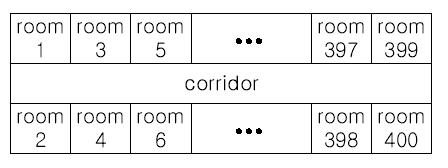hdu_1050 Moving Tables 贪心
Moving Tables
Time Limit: 2000/1000 MS (Java/Others) Memory Limit: 65536/32768 K (Java/Others)
Total Submission(s): 45555 Accepted Submission(s): 14817

The floor has 200 rooms each on the north side and south side along the corridor. Recently the Company made a plan to reform its system. The reform includes moving a lot of tables between rooms. Because the corridor is narrow and all the tables are big, only one table can pass through the corridor. Some plan is needed to make the moving efficient. The manager figured out the following plan: Moving a table from a room to another room can be done within 10 minutes. When moving a table from room i to room j, the part of the corridor between the front of room i and the front of room j is used. So, during each 10 minutes, several moving between two rooms not sharing the same part of the corridor will be done simultaneously. To make it clear the manager illustrated the possible cases and impossible cases of simultaneous moving.

For each room, at most one table will be either moved in or moved out. Now, the manager seeks out a method to minimize the time to move all the tables. Your job is to write a program to solve the manager’s problem.
这个题真是迷了, 一开始想的就是每次能搬尽量多的桌子,这样就能最快搬完,所以按照区间的右端排的序。
Input Output
data[i].s = (data[i].s+1)/2; data[i].t = (data[i].t+1)/2;
#include <iostream>
#include <stdio.h>
#include <algorithm> using namespace std; struct dat
{
int s;
int t;
int visit;
} data[]; bool cmp(dat a, dat b)
{
return a.s<b.s; // return a.t<b.t 是错的
} int main()
{
int t, n; scanf("%d",&t);
while(t--)
{
scanf("%d",&n);
for(int i=; i<n; i++)
{
scanf("%d%d",&data[i].s, &data[i].t);
if(data[i].s>data[i].t)
{
int temp = data[i].s;
data[i].s = data[i].t;
data[i].t = temp;
}
data[i].s = (data[i].s+)/;
data[i].t = (data[i].t+)/;
data[i].visit=;
//printf("%d%d\n",data[i].s,data[i].t);
} sort(data, data+n, cmp); int ans=, j, temp; for(int i=; i<n; i++)
{
if(!data[i].visit)
{
j=i+;
temp = i;
data[i].visit=;
while(j!=n)
{
if(!data[j].visit&&data[temp].t < data[j].s)
{
data[j].visit=;
temp=j;
}
j++;
}
ans++;
}
} printf("%d\n", ans*); }
return ;
}
另一种思路就是区间覆盖,找覆盖次数最大的点的覆盖次数。
hdu_1050 Moving Tables 贪心的更多相关文章
- Moving Tables(贪心或Dp POJ1083)
Moving Tables Time Limit: 1000MS Memory Limit: 10000K Total Submissions: 28304 Accepted: 9446 De ...
- zstu.2512. Moving Tables(贪心)
Moving Tables Time Limit: 1 Sec Memory Limit: 64 MB Submit: 1182 Solved: 563 Description The famo ...
- HDU1050(Moving Tables:贪心算法)
解题思路: 这种做法是基于hdu2037的做法上考虑的,找出所有可以同时搬运的桌子,然后就很方便求出最短总时间. 还有一种更简单的做法是直接遍历一遍找出与别的重复次数最多的那片区域,重复次数*10就可 ...
- UVAlive 2326 Moving Tables(贪心 + 区间问题)
The famous ACM (Advanced Computer Maker) Company has rented a floor of a building whose shape is in ...
- --hdu 1050 Moving Tables(贪心)
题目链接:http://acm.hdu.edu.cn/showproblem.php?pid=1050 AC code: #include<stdio.h> #include<str ...
- POJ 1083 && HDU 1050 Moving Tables (贪心)
Moving Tables Time Limit: 2000/1000 MS (Java/Others) Memory Limit: 65536/32768 K (Java/Others) To ...
- hdoj 1050 Moving Tables【贪心区间覆盖】
Moving Tables Time Limit: 2000/1000 MS (Java/Others) Memory Limit: 65536/32768 K (Java/Others)Tot ...
- HDOJ 1050 Moving Tables
Moving Tables Time Limit: 2000/1000 MS (Java/Others) Memory Limit: 65536/32768 K (Java/Others)Tot ...
- Moving Tables
Moving Tables Time Limit : 2000/1000ms (Java/Other) Memory Limit : 65536/32768K (Java/Other) Total ...
随机推荐
- D - 淡黄的长裙 HDU - 4221(贪心)
D - 淡黄的长裙 HDU - 4221(贪心) James is almost mad! Currently, he was assigned a lot of works to do, so ma ...
- Please enter a commit message to explain why this merge is necessary, # especially if it merges an updated upstream into a topic branch. # # Lines starting with '#' will be ignored, and an empty messa
1.git提交的时候遇到: # Please enter the commit message for your changes. Lines starting with '#' will be ig ...
- javascript中常见的表单验证项
1.不能超过20个字符 <body> <form name=a onsubmit="return test()"> <textarea name=&q ...
- .NET Core项目部署到Linux(Centos7)(三)创建.NET Core API项目
目录 1.前言 2.环境和软件的准备 3.创建.NET Core API项目 4.VMware Workstation虚拟机及Centos 7安装 5.Centos 7安装.NET Core环境 6. ...
- shell脚本实现自动压缩一天前的日志文件 ,并传到ftp服务器上
shell脚本实现自动压缩一天前的日志文件 ,并传到ftp服务器上 naonao_127关注2人评论19401人阅读2012-06-08 11:26:16 生产环境下脚本自动备份脚本是 ...
- 查找 mysql 配置文件 my.cnf
$ locate my.cnf 看看你的linux上有多少个my.cnf,一般都配置为/etc/my.cnf
- MTK Android Driver :Battery电池曲线
MTK Android Driver :battery电池曲线 1.配置文件位置: CUSTOM_KERNEL_BATTERY= battery mediatek\custom\\kernel\bat ...
- Vue-router 第10节 路由中的钩子
Vue-router 第10节 路由中的钩子 [TOC] 第10节 路由中的钩子 我们知道一个组件从进入到销毁有很多的钩子函数,同样在路由中也设置了钩子函数.路由的钩子选项可以写在路由配置文件中,也可 ...
- "浮动按钮"组件:<fab> —— 快应用组件库H-UI
    <import name="fab" src="../Common/ui/h-ui/basic/c_fab"></import ...
- springboot httpsession.getAtt....is null
1.开始怀疑是 @RequestMapping("") public String loginIndex() { return "admin/login"; } ...
